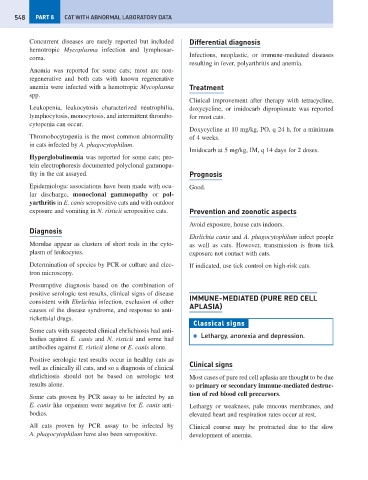Page 556 - Problem-Based Feline Medicine
P. 556
548 PART 8 CAT WITH ABNORMAL LABORATORY DATA
Concurrent diseases are rarely reported but included Differential diagnosis
hemotropic Mycoplasma infection and lymphosar-
Infectious, neoplastic, or immune-mediated diseases
coma.
resulting in fever, polyarthritis and anemia.
Anemia was reported for some cats; most are non-
regenerative and both cats with known regenerative
anemia were infected with a hemotropic Mycoplasma Treatment
spp.
Clinical improvement after therapy with tetracycline,
Leukopenia, leukocytosis characterized neutrophilia, doxycycline, or imidocarb dipropionate was reported
lymphocytosis, monocytosis, and intermittent thrombo- for most cats.
cytopenia can occur.
Doxycycline at 10 mg/kg, PO, q 24 h, for a minimum
Thromobocytopenia is the most common abnormality of 4 weeks.
in cats infected by A. phagocytophilum.
Imidocarb at 5 mg/kg, IM, q 14 days for 2 doses.
Hyperglobulinemia was reported for some cats; pro-
tein electrophoresis documented polyclonal gammopa-
thy in the cat assayed. Prognosis
Epidemiologic associations have been made with ocu- Good.
lar discharge, monoclonal gammopathy or pol-
yarthritis in E. canis seropositive cats and with outdoor
exposure and vomiting in N. risticii seropositive cats. Prevention and zoonotic aspects
Avoid exposure, house cats indoors.
Diagnosis
Ehrlichia canis and A. phagocytophilum infect people
Morulae appear as clusters of short rods in the cyto- as well as cats. However, transmission is from tick
plasm of leukocytes. exposure not contact with cats.
Determination of species by PCR or culture and elec- If indicated, use tick control on high-risk cats.
tron microscopy.
Presumptive diagnosis based on the combination of
positive serologic test results, clinical signs of disease
IMMUNE-MEDIATED (PURE RED CELL
consistent with Ehrlichia infection, exclusion of other
APLASIA)
causes of the disease syndrome, and response to anti-
rickettsial drugs.
Classical signs
Some cats with suspected clinical ehrlichiosis had anti-
● Lethargy, anorexia and depression.
bodies against E. canis and N. risticii and some had
antibodies against E. risticii alone or E. canis alone.
Positive serologic test results occur in healthy cats as
Clinical signs
well as clinically ill cats, and so a diagnosis of clinical
ehrlichiosis should not be based on serologic test Most cases of pure red cell aplasia are thought to be due
results alone. to primary or secondary immune-mediated destruc-
tion of red blood cell precursors.
Some cats proven by PCR assay to be infected by an
E. canis like organism were negative for E. canis anti- Lethargy or weakness, pale mucous membranes, and
bodies. elevated heart and respiration rates occur at rest.
All cats proven by PCR assay to be infected by Clinical course may be protracted due to the slow
A. phagocytophilum have also been seropositive. development of anemia.

